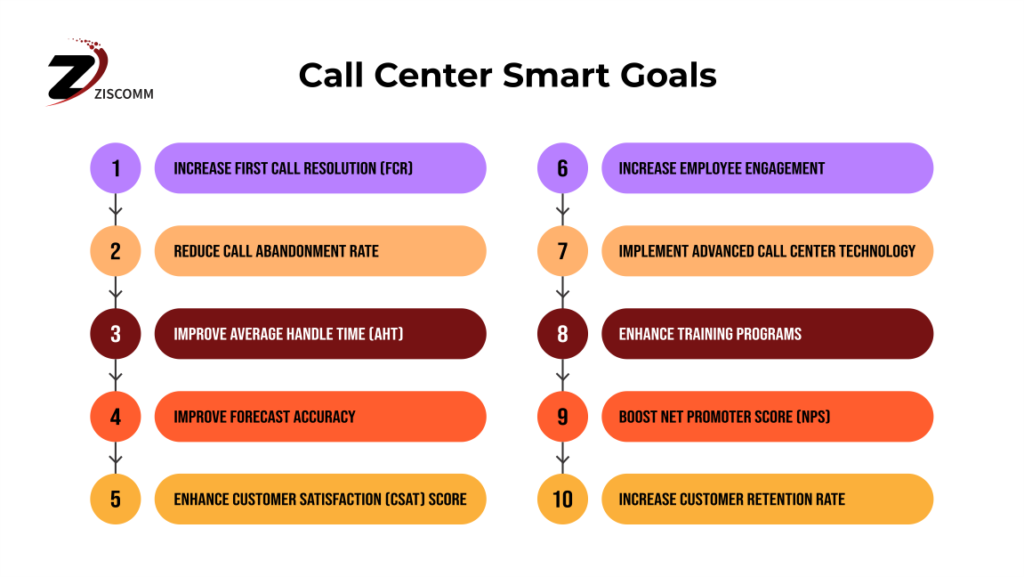Table of Contents
In the competitive and busy world of call centers, setting strategic and call center smart goals is important for maintaining high performance and ensuring customer satisfaction. Implementing smart goals (Specific, Measurable, Achievable, Relevant, Time-bound) can significantly improve the productivity and efficiency of call center operations. In this article, we will study the importance of smart goals in call centers and also discuss 23 smart goals in call centers to help managers and agents achieve success.
Call Center Goal Examples
1. Increase First Call Resolution (FCR)
Increasing the First Call Resolution (FCR) rate is an important goal for any call center aiming to improve customer satisfaction and operational efficiency. Increase first call resolution goal is specific, targeting the resolution of customer issues on the first call. It is measurable, with an objective to achieve an FCR rate of 85%, providing a clear example of success.
To achieve an 85% FCR rate, call centers are essential to equip agents with better tools and resources and provide extensive training on common issues and their solutions. Providing extensive training on common issues and solutions ensures that agents are well-prepared to handle a wide range of customer inquiries effectively.
The relevance of improving FCR rates cannot be overstated; it directly reduces the number of repeat calls, which not only lowers operational costs but also significantly improves the overall customer experience. Customers appreciate quick and efficient service, and resolving their issues on the first call builds trust and loyalty.
Setting a time-bound target to achieve this goal within four months creates a sense of urgency and focus, ensuring that necessary improvements and training are implemented promptly.
Overall, improving FCR rates is a strategic objective that drives better service delivery, increases customer satisfaction, and optimizes call center performance.
2. Reduce Call Abandonment Rate
Reducing the call abandonment rate is an essential smart goal for call centers aiming to improve customer satisfaction and operational efficiency. The reduce call abandonment rate goal specifically targets decreasing the rate at which customers abandon calls before receiving help. By lowering the call abandonment rate to less than 5%, call centers can significantly improve the customer experience.
Achieving this smart goal is possible by optimizing call routing systems and reducing wait times through improved scheduling and staffing strategies. These measures ensure that customers spend less time on hold and are more likely to stay on the line until their issues are resolved. The relevance of this goal is paramount, as high abandonment rates can lead to customer frustration, dissatisfaction, and potential loss of business.
Ensuring that more customers receive timely support not only boosts satisfaction but also improves the overall reputation of the call center. Setting a time-bound target to reduce the call abandonment rate within three months creates a sense of urgency and focus, driving the team to implement necessary changes promptly and efficiently.
By addressing call abandonment, call centers can ensure a more smooth and satisfactory customer service experience, leading to improved customer loyalty and retention.

3. Improve Average Handle Time (AHT)
Improving Average Handle Time (AHT) is an essential call center smart goal, directly impacting customer satisfaction and operational efficiency. The objective is to reduce AHT by 20% over the next quarter. This specific, measurable, and time-bound goal ensures a clear target and defined timeframe.
To achieve this, call centers should implement training sessions focused on effective communication and quick problem-solving, equipping agents with the necessary skills.
Reducing AHT is highly relevant as it leads to shorter wait times, allowing agents to assist more customers efficiently. This efficiency improves the customer experience by minimizing frustration and wait times and improves call center productivity.
Efficient call handling better uses resources, managing more calls with the same number of agents, leading to potential cost savings. Achieving this goal within the next quarter sets a motivating deadline, encouraging immediate and focused action to improve service delivery.
4. Improve Forecast Accuracy
Improving the accuracy of call volume forecasts is a key goal for call centers to run smoothly and provide better customer service. Aiming for 95% forecast accuracy gives a clear, measurable target. Improve forecast accuracy can be achieved by using past data and advanced analytics to fine-tune forecasting methods.
Accurate forecasts are important because they help with efficient staffing and resource allocation. When call volumes are predicted accurately, call centers can have the right number of agents at the right times, reducing customer wait times and avoiding costly over staffing.
Setting a six-month deadline for this smart goal ensures it remains a priority and progress is tracked. Ultimately, better forecast accuracy leads to a more efficient and responsive call center, improving customer satisfaction and overall operations.
Recommended: What is Call Center?: Definition, Types of Call Center
5. Enhance Customer Satisfaction (CSAT) Score
Improving the customer satisfaction (CSAT) score must be a smart goal for any call center focused on delivering high-quality service and fostering customer loyalty. The goal is to achieve a CSAT score of 90% or higher within six months. Improving the customer satisfaction score can be measured through regular surveys and feedback mechanisms.
To reach this target, essential for call centers to implement a robust customer feedback loop and provide comprehensive training for agents on customer service best practices.
Improving the CSAT score is important because it directly impacts customer retention and brand loyalty. Higher CSAT scores indicate that customers are satisfied, making consumers more likely to continue using the company’s services and recommend services to others. Higher CSAT scores not only improve the company’s reputation but also boost employee confidence by recognizing agents’ efforts. By focusing on CSAT improvements, call centers can ensure they remain competitive and meet the evolving demands of their customers.
6. Increase Employee Engagement
Boosting employee engagement and satisfaction within a call center is important for improving overall performance and reducing turnover rates. The goal is to achieve an 80% engagement score in the next employee survey, which can be measured and tracked.
This is possible by implementing regular team-building activities, offering professional development opportunities, and recognizing outstanding performance.
Higher employee engagement leads to better productivity and loyalty, making it highly relevant for organizational success. Setting a one-year timeframe provides speed and focus, ensuring that initiatives to improve engagement are timely and effective. By achieving this goal, call center managers can promote a more positive and productive work environment, benefiting both employees and the organization.
7. Implement Advanced Call Center Technology
One of the essential call center smart goals is to implement advanced technology to boost efficiency and improve customer service. Upgrading to AI-driven analytics, CRM systems, and omnichannel support can significantly improve operational performance.
By integrating at least three new technologies within the next year, call centers can simplify processes, providing agents with the tools they need to excel. Allocating a budget for these upgrades and training staff ensures the changes are both feasible and impactful. Advanced technology not only improves agent productivity but also elevates customer satisfaction, making it a crucial step toward achieving long-term success.
8. Enhance Training Programs
Developing complete training programs for new and existing agents is an important goal for a call center to improve overall call center performance. By increasing the number of training hours per agent to 40 hours per year, managers can ensure that agents are well-equipped to handle various customer interactions effectively.
Creating a structured training curriculum and scheduling regular sessions makes this goal achievable. Well-trained agents are more efficient, provide superior customer service, and contribute to higher customer satisfaction. Implementing these new training programs within six months ensures timely improvements, making the call center more competitive and responsive to customer needs.
Recommended: 11 Advantages of Call Centers
9. Boost Net Promoter Score (NPS)
One of the necessary call center smart goals is to boost the Net Promoter Score (NPS), an important metric for gauging customer loyalty. To achieve a net promoter score (NPS, aim for an NPS of 50 or higher within a year. To boost the Net Promoter Score goal is measurable and achievable by focusing on improving service quality, resolving issues promptly, and gathering regular feedback from customers.
A high NPS is essential as it means strong customer loyalty and generates positive word-of-mouth, which can significantly improve the reputation and growth of the call center.
10. Increase Customer Retention Rate
One of the necessary call center smart goals is to increase the customer retention rate. Boost customer retention involves improving the rate at which customers stay loyal to the company. A specific, measurable target is to boost the customer retention rate by 10% within a year. Achieving the goal of increasing customer retention requires developing strong loyalty programs and improving customer support services.
Retaining customers is significantly more cost-effective than acquiring new ones, making this goal highly relevant for long-term business success. By focusing on customer retention, call centers can ensure sustained growth and profitability.
11. Improve Self-Service Options
Improving self-service options is a necessary component of call center smart goals. By improving self-service capabilities, such as developing comprehensive FAQs, implementing chatbots, and optimizing IVR systems, call centers can significantly increase self-service usage by 30%. This strategic initiative is not only achievable but also essential, as effective self-service reduces call volumes and improves customer satisfaction.
With a clear timeline of six months for implementation, this smart goal of improving self-service options ensures that customers have immediate access to the information and assistance consumer need, thereby simplifying operations and promoting a positive customer experience.
Recommended: What Does Inbound and Outbound Call Center Mean?
12. Enhance Agent Productivity
One of the most impactful call center smart goals is to improve agent productivity. Specifically, this involves improving the productivity of call center agents by increasing the number of calls handled per agent by 15%. This goal of improving agent productivity is measurable, allowing managers to track progress accurately.
Achieving this involves implementing productivity tools and simplifying workflows, making it both achievable and practical. Higher productivity is highly relevant as it leads to better resource utilization and significant cost savings. Setting a time-bound target of six months ensures focused efforts and timely results.
Improving agent productivity not only boosts overall efficiency but also contributes to superior customer service and operational success.
13. Increase Use of Customer Feedback
One of the most impactful call center smart goals is to increase the use of customer feedback. By conducting monthly customer feedback surveys and analyzing the results, call centers can gain valuable information into areas needing improvement.
Establishing a dedicated feedback analysis team ensures that these insights are systematically reviewed and action plans are developed. This goal of increasing the use of customer feedback is not only achievable but also essential, as customer feedback is a critical driver of continuous improvement and customer satisfaction. Implementing this feedback system within two months allows for timely adjustments, ensuring that the call center continually evolves to meet customer needs and expectations.
14. Develop a Service Recovery Program
Developing a service recovery program is a critical call center smart goal aimed at managing and resolving customer complaints efficiently. By establishing a dedicated program, call centers can significantly reduce the number of incomplete complaints by 50%, ensuring a higher level of customer satisfaction. This goal involves training agents on effective service recovery techniques and implementing a strong feedback system.
Addressing complaints promptly and effectively not only resolves issues but also has the potential to turn unhappy customers into loyal advocates for the brand. Implementing this program within three months shows a commitment to continuous improvement and improves the overall customer experience.
15. Enhance Data Analytics Capabilities
Improving the data analytics capabilities of a call center is an important smart goal that can drive significant developments in overall performance. By investing in advanced analytics tools and training staff on data analysis, call centers can increase the number of data-driven decisions by 25% within six months. This objective is highly relevant as data-driven decisions lead to better performance and deeper customer insights.
Effective data analysis allows call centers to identify trends, optimize operations, and personalize customer relations, thereby improving efficiency and customer satisfaction. In the competitive landscape of customer service, using data analytics is essential for maintaining a high standard of service and staying ahead of the competition.
Adopting this call center smart goal provides a structured approach to harnessing the power of data for continuous improvement and strategic growth.
16. Increase Agent Adherence to Schedules
One of the crucial call center smart goals is to increase agent commitment to schedules. Ensuring that agents consistently stick to their schedules is essential for maintaining optimal staffing levels and providing timely customer service. By aiming to achieve a 95% schedule compliance rate within three months, call centers can implement real-time observation monitoring and provide regular feedback to agents. This not only helps in maintaining good staffing but also ensures that customers receive prompt and efficient service, thereby improving overall operational efficiency and customer satisfaction.
17. Optimize Workforce Management
One of the necessary call center smart goals is to optimize workforce management. This goal of boosting workforce productivity focuses on improving the efficiency of workforce management by reducing workforce-related costs by 15%. By implementing advanced workforce management software and optimizing scheduling processes, call centers can ensure the highest staffing levels and significant cost savings.
Efficient workforce management not only guarantees that the right number of agents are available to handle call volumes but also improves overall productivity and customer satisfaction. Achieving this within six months underscores the urgency and importance of simplifying operations to maintain competitive advantage and operational excellence.
18. Enhance Employee Recognition Programs
One of the key call center smart goals is to improve employee recognition programs. Advanced employee recognition programs involve developing specific programs to recognize and reward top-performing employees. Implementing a quarterly recognition program aims to increase employee satisfaction scores by 20%.
Achievable through the creation of a recognition committee and the allocation of a budget for rewards, this goal is highly relevant as recognition programs boost morale and motivate employees to perform better. By launching this program within three months, call centers can promote a positive work environment, leading to increased productivity and improved overall performance.
19. Improve Multi Channel Support
One of the critical call center smart goals is to improve multichannel support, ensuring smooth customer service across phone, email, and chat. By training agents to handle multiple communication channels and integrating strong support systems, call centers can achieve a customer satisfaction score of 90% across all channels.
This goal to boost employee recognition programs is not only achievable but also highly relevant, as providing consistent support improves the overall customer experience. Implementing these improvements within six months will simplify operations, boost efficiency, and foster a more cohesive and responsive support environment, ultimately leading to higher customer satisfaction and loyalty.
20. Increase Use of AI and Automation
One of the crucial call center smart goals is to increase the use of AI and automation within operations. Specifically, this goal focuses on integrating AI tools to automate 50% of routine tasks within a year. By investing in advanced AI technologies and providing complete training for staff, call centers can improve efficiency and allow agents to focus on more complex customer issues.
The goal of expanding AI and automation is highly relevant as automation simplifies processes, reduces operational costs, and ultimately improves customer satisfaction by ensuring quicker and more accurate service.
21. Improve Conflict Resolution Skills
One of the crucial call center smart goals is to improve agents’ abilities to resolve conflicts effectively. The goal of developing conflict resolution skills is specific, aiming to reduce the number of escalated calls by 30%, which is a measurable target. Achieving this involves providing agents with complete training on conflict resolution techniques.
Effective conflict resolution is highly relevant as it significantly improves customer satisfaction and reduces stress for agents, leading to a more positive work environment. By implementing this training program within three months, call centers can ensure that their agents are well-equipped to handle disputes efficiently, fostering better customer relationships and improving overall service quality.
22. Foster Team Collaboration
One of the most vital call center smart goals is to promote team collaboration. By improving collaboration among team members, call centers can improve problem-solving capabilities and drive innovation. This goal is specifically increasing the number of team projects by 50%.
It’s measurable, achievable through the implementation of team-building activities and collaboration tools, and highly relevant as it directly contributes to a more connected and efficient team environment. Setting a time-bound objective to achieve this within six months ensures a focused and structured approach.
Prioritizing team collaboration not only boosts employee morale but also leads to higher productivity and better customer service outcomes.
23. Expand Language Support
One of the essential call center smart goals is to expand language support to cater to a diverse customer base. This goal of increasing language support involves offering support in multiple languages, specifically by providing assistance in at least three new languages within a year.
To achieve this, call centers should hire multilingual agents and provide language training for existing staff. Implementing multilingual support is crucial because it directly meets the needs of a diverse customer base, improving overall customer satisfaction.
By setting and achieving this goal of diversifying language support, call centers can ensure they are embracing and responsive to all customers, leading to enhanced loyalty and a broader market reach.
Importance of Smart Goals in Call Centers
Setting smart goals—Specific, Measurable, Achievable, Relevant, and Time-bound—in call centers is important for several reasons. These goals provide clear direction, improve performance, and match individual efforts with broader business objectives.
1. Clarity and Focus
Smart goals bring clarity and focus to call center operations. By defining specific objectives, call centers can ensure that every action taken by agents and managers aligns with the desired outcomes. This clarity helps in prioritizing tasks, managing time effectively, and reducing opacity in daily operations.
2. Performance Measurement
Measurable goals help call centers track progress and assess performance accurately. Metrics such as average handle time (AHT), first call resolution (FCR), and customer satisfaction scores (CSAT) provide concrete data to evaluate success and identify areas for improvement. Regularly measuring these metrics ensures that call centers can make informed decisions and adjust strategies as needed.
3. Motivation and Accountability
Achievable goals motivate employees by providing possible targets. When agents and managers know that their goals are realistic, they are more likely to stay engaged and committed to their work. Additionally, time-bound goals create a sense of urgency and accountability, ensuring that everyone works towards meeting deadlines and achieving results within a specific timeframe.
4. Alignment with Business Objectives
Relevant goals ensure that individual efforts contribute to the overall success of the organization. By matching call center objectives with broader business goals, such as improving customer satisfaction or increasing efficiency, call centers can support the company’s mission and vision. This alignment fosters an integrated work environment where every team member understands their role in the bigger picture.
5. Continuous Improvement
Smart goals drive continuous improvement by promoting regular review and refinement of processes. Setting specific and measurable targets helps call centers identify inefficiencies and implement changes that enhance performance. This ongoing process of evaluation and adjustment leads to sustained growth and better service delivery.
Call Center Smart Goals: Final Thoughs
Setting smart goals in call centers is a strategic approach to improving performance, improving customer satisfaction, and matching individual efforts with broader business objectives. By following the smart criteria, call center managers and agents can create a structured path toward continuous improvement and operational excellence. Implementing these goals not only boosts productivity but also promotes a positive and motivated work environment, ultimately leading to better service delivery and customer loyalty.





